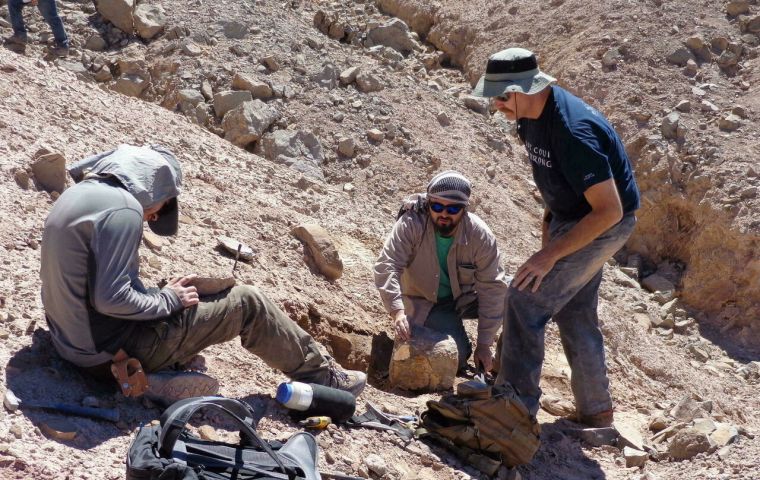MercoPress. South Atlantic News Agency
Remains found by Chilean scientists determined to belong to prehistoric flying dragon
 These “enigmatic winged dragons” were characterized by having a wingspan of up to two meters
These “enigmatic winged dragons” were characterized by having a wingspan of up to two meters Fossil remains found by a Chilean research team in the Atacama Desert have been determined to belong to a prehistoric pterosaur flying dragon, it was reported.
The flying reptile was said to have lived during the Jurassic period, about 160 million years ago, according to the University of Chile.
During an expedition carried out in 2009 in the town of Cerritos Bayos, about 30 km from the city of Calama, in the middle of the Atacama desert, the group of researchers discovered very well preserved fossil remains of an unknown species, which they believed could be of a prehistoric marine animal from the Jurassic period.
However, subsequent analyzes determined that it was a pterosaur close to the adult stage, belonging to the Ramphorhynchinae subfamily of which a left humerus, a possible dorsal vertebra and two fragments of a phalanx of the wing were found, all preserved in three dimensions.
The article reporting the fossil finding was published this week in the quarterly scientific journal Acta Paleontológica Polonica, edited by the Institute of Paleobiology of the Polish Academy of Sciences.
These “enigmatic winged dragons” were characterized by having a wingspan of up to two meters, explained the Chilean scientist Jhonatan Alarcon who led the studies of the pterosaur fossils.
These animals “were characterized by having a very elongated tail and a peculiar rhombus-shaped ending. They also had low heads, long snouts and point-shaped forward teeth,“ he added.
These remains are the first of their kind found in the Southern Hemisphere, particularly in territories of the ancient mega continent Gondwana that existed about 550 million years ago and that was made up of territories such as South America, Antarctica, Africa, Madagascar, India and Australia and Laurasia, consisting mainly of North America, Asia and Europe.
”All the discoveries of the Rhamphorhynchinae subfamily come essentially from the northern hemisphere, mainly from Europe. With this, we show that the distribution of the animals in this group was wider than what was known up to now,” explained Alarcón.
Cerritos Bayos has been an area of important paleontological findings. This same team discovered 2020 plesiosaurs of the genera Muraenosaurus and Vinialesaurus, and also the first remains of pliosaurs (relatives of the Plesiosaurs, but with large skulls and short necks).




Top Comments
Disclaimer & comment rulesCommenting for this story is now closed.
If you have a Facebook account, become a fan and comment on our Facebook Page!